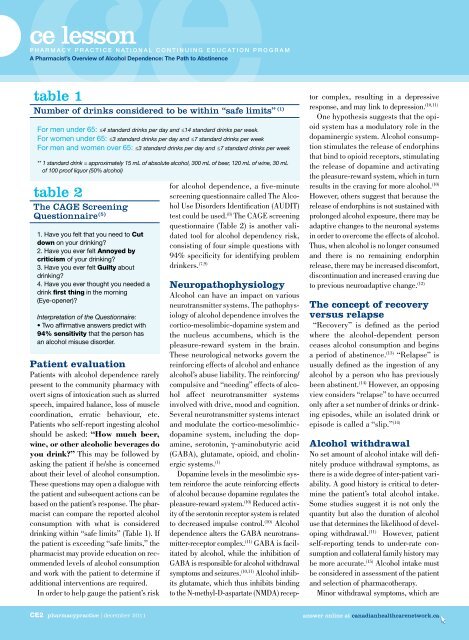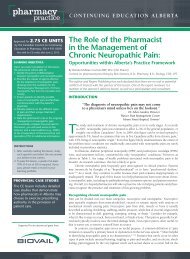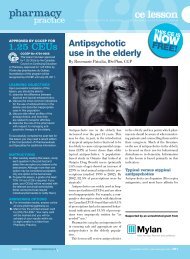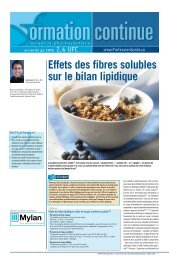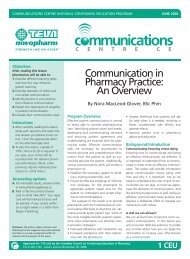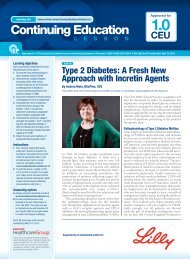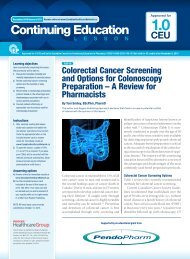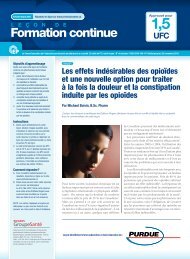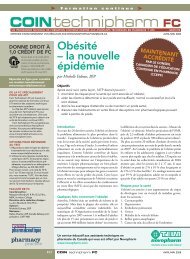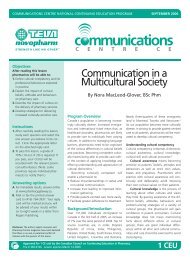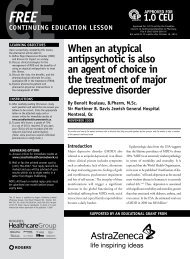cece lesson
cece lesson
cece lesson
You also want an ePaper? Increase the reach of your titles
YUMPU automatically turns print PDFs into web optimized ePapers that Google loves.
ce <strong>lesson</strong>Pharmacy Practice national continuing education programA Pharmacist’s Overview of Alcohol Dependence: The Path to Abstinencetable 1Number of drinks considered to be within “safe limits” (1)For men under 65: ≤4 standard drinks per day and ≤14 standard drinks per week.For women under 65: ≤3 standard drinks per day and ≤7 standard drinks per weekFor men and women over 65: ≤3 standard drinks per day and ≤7 standard drinks per week** 1 standard drink = approximately 15 mL of absolute alcohol, 300 mL of beer, 120 mL of wine, 30 mLof 100 proof liquor (50% alcohol)table 2The CAGE ScreeningQuestionnaire (5)1. Have you felt that you need to Cutdown on your drinking?2. Have you ever felt Annoyed bycriticism of your drinking?3. Have you ever felt Guilty aboutdrinking?4. Have you ever thought you needed adrink first thing in the morning(Eye-opener)?Interpretation of the Questionnaire:• Two affirmative answers predict with94% sensitivity that the person hasan alcohol misuse disorder.Patient evaluationPatients with alcohol dependence rarelypresent to the community pharmacy withovert signs of intoxication such as slurredspeech, impaired balance, loss of musclecoordination, erratic behaviour, etc.Patients who self-report ingesting alcoholshould be asked: “How much beer,wine, or other alcoholic beverages doyou drink?” This may be followed byasking the patient if he/she is concernedabout their level of alcohol consumption.These questions may open a dialogue withthe patient and subsequent actions can bebased on the patient’s response. The pharmacistcan compare the reported alcoholconsumption with what is considereddrinking within “safe limits” (Table 1). Ifthe patient is exceeding “safe limits,” thepharmacist may provide education on recommendedlevels of alcohol consumptionand work with the patient to determine ifadditional interventions are required.In order to help gauge the patient’s riskfor alcohol dependence, a five-minutescreening questionnaire called The AlcoholUse Disorders Identification (AUDIT)test could be used. (8) The CAGE screeningquestionnaire (Table 2) is another validatedtool for alcohol dependency risk,consisting of four simple questions with94% specificity for identifying problemdrinkers. (7,9)NeuropathophysiologyAlcohol can have an impact on variousneurotransmitter systems. The pathophysiologyof alcohol dependence involves thecortico-mesolimbic-dopamine system andthe nucleus accumbens, which is thepleasure-reward system in the brain.These neurological networks govern thereinforcing effects of alcohol and enhancealcohol’s abuse liability. The reinforcing/compulsive and “needing” effects of alcoholaffect neurotransmitter systemsinvolved with drive, mood and cognition.Several neurotransmitter systems interactand modulate the cortico-mesolimbicdopaminesystem, including the dopamine,serotonin, g-aminobutyric acid(GABA), glutamate, opioid, and cholinergicsystems. (1)Dopamine levels in the mesolimbic systemreinforce the acute reinforcing effectsof alcohol because dopamine regulates thepleasure-reward system. (10) Reduced activityof the serotonin receptor system is relatedto decreased impulse control. (10) Alcoholdependence alters the GABA neurotransmitter-receptorcomplex. (11) GABA is facilitatedby alcohol, while the inhibition ofGABA is responsible for alcohol withdrawalsymptoms and seizures. (10,11) Alcohol inhibitsglutamate, which thus inhibits bindingto the N-methyl-D-aspartate (NMDA) receptorcomplex, resulting in a depressiveresponse, and may link to depression. (10,11)One hypothesis suggests that the opioidsystem has a modulatory role in thedopaminergic system. Alcohol consumptionstimulates the release of endorphinsthat bind to opioid receptors, stimulatingthe release of dopamine and activatingthe pleasure-reward system, which in turnresults in the craving for more alcohol. (10)However, others suggest that because therelease of endorphins is not sustained withprolonged alcohol exposure, there may beadaptive changes to the neuronal systemsin order to overcome the effects of alcohol.Thus, when alcohol is no longer consumedand there is no remaining endorphinrelease, there may be increased discomfort,discontinuation and increased craving dueto previous neuroadaptive change. (12)The concept of recoveryversus relapse“Recovery” is defined as the periodwhere the alcohol-dependent personceases alcohol consumption and beginsa period of abstinence. (13) “Relapse” isusually defined as the ingestion of anyalcohol by a person who has previouslybeen abstinent. (14) However, an opposingview considers “relapse” to have occurredonly after a set number of drinks or drinkingepisodes, while an isolated drink orepisode is called a “slip.” (14)Alcohol withdrawalNo set amount of alcohol intake will definitelyproduce withdrawal symptoms, asthere is a wide degree of inter-patient variability.A good history is critical to determinethe patient’s total alcohol intake.Some studies suggest it is not only thequantity but also the duration of alcoholuse that determines the likelihood of developingwithdrawal. (11) However, patientself-reporting tends to under-rate consumptionand collateral family history maybe more accurate. (15) Alcohol intake mustbe considered in assessment of the patientand selection of pharmacotherapy.Minor withdrawal symptoms, which areCE2 pharmacypractice | december 2011answer online at canadianhealthcarenetwork.ca


